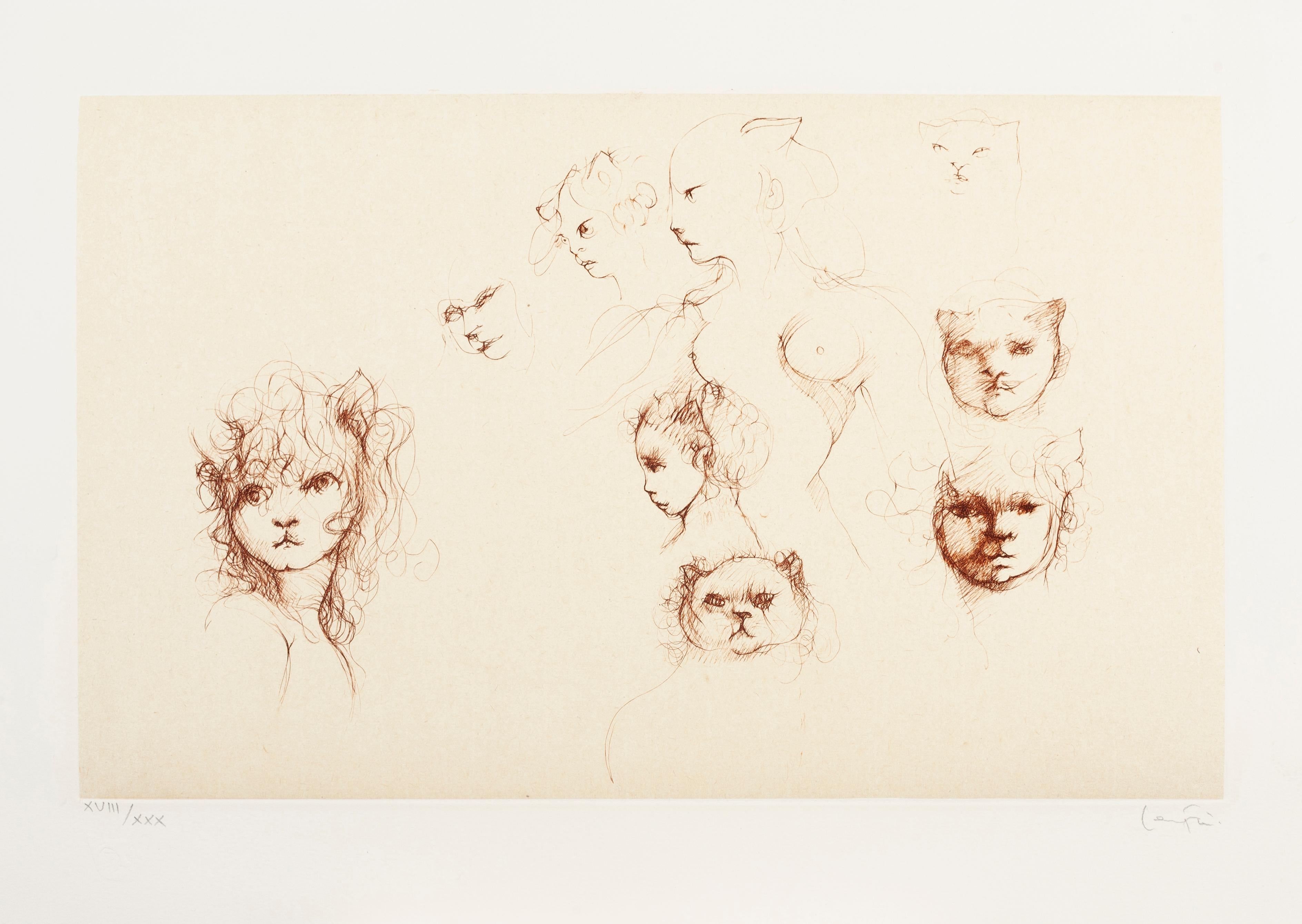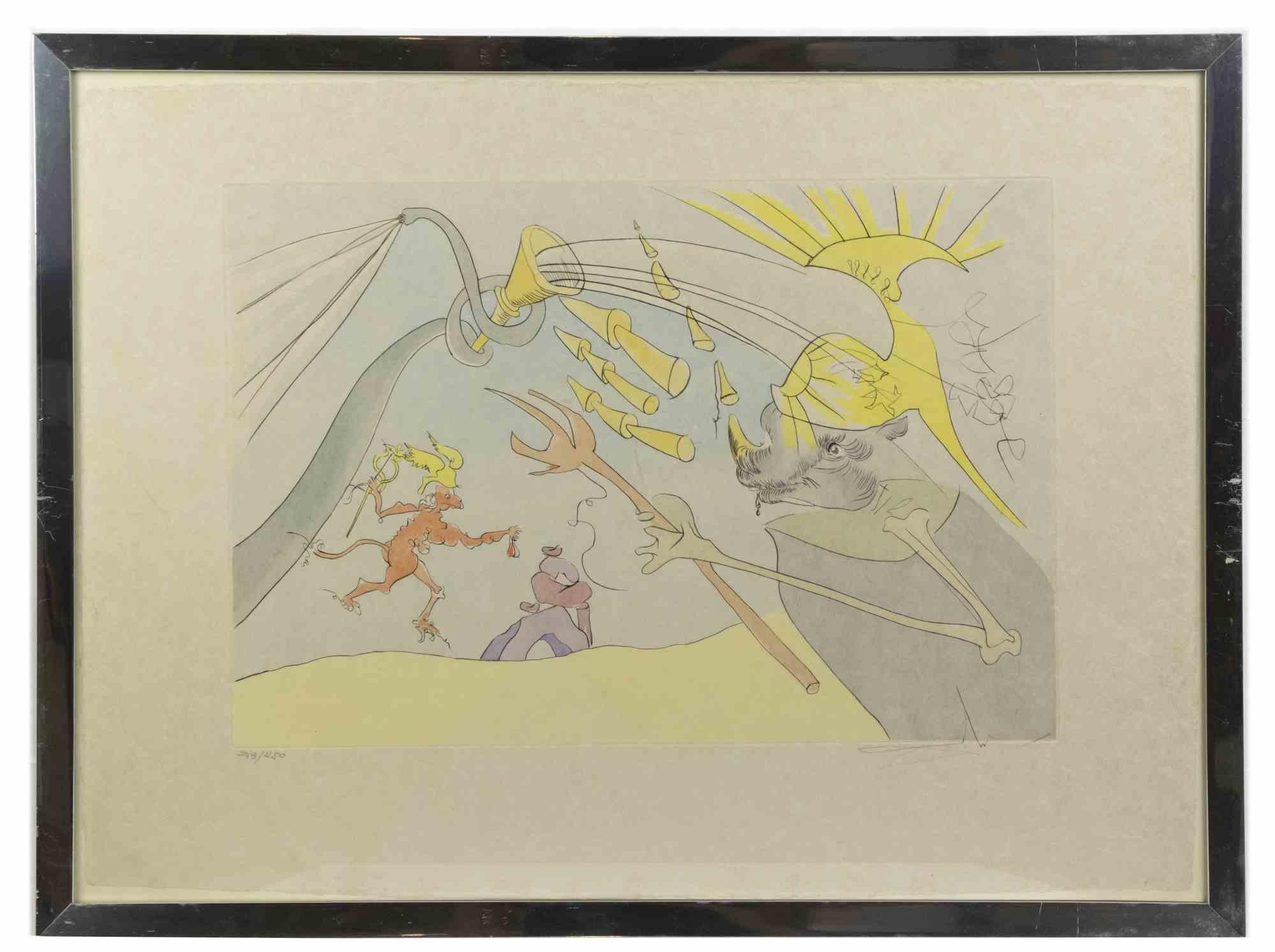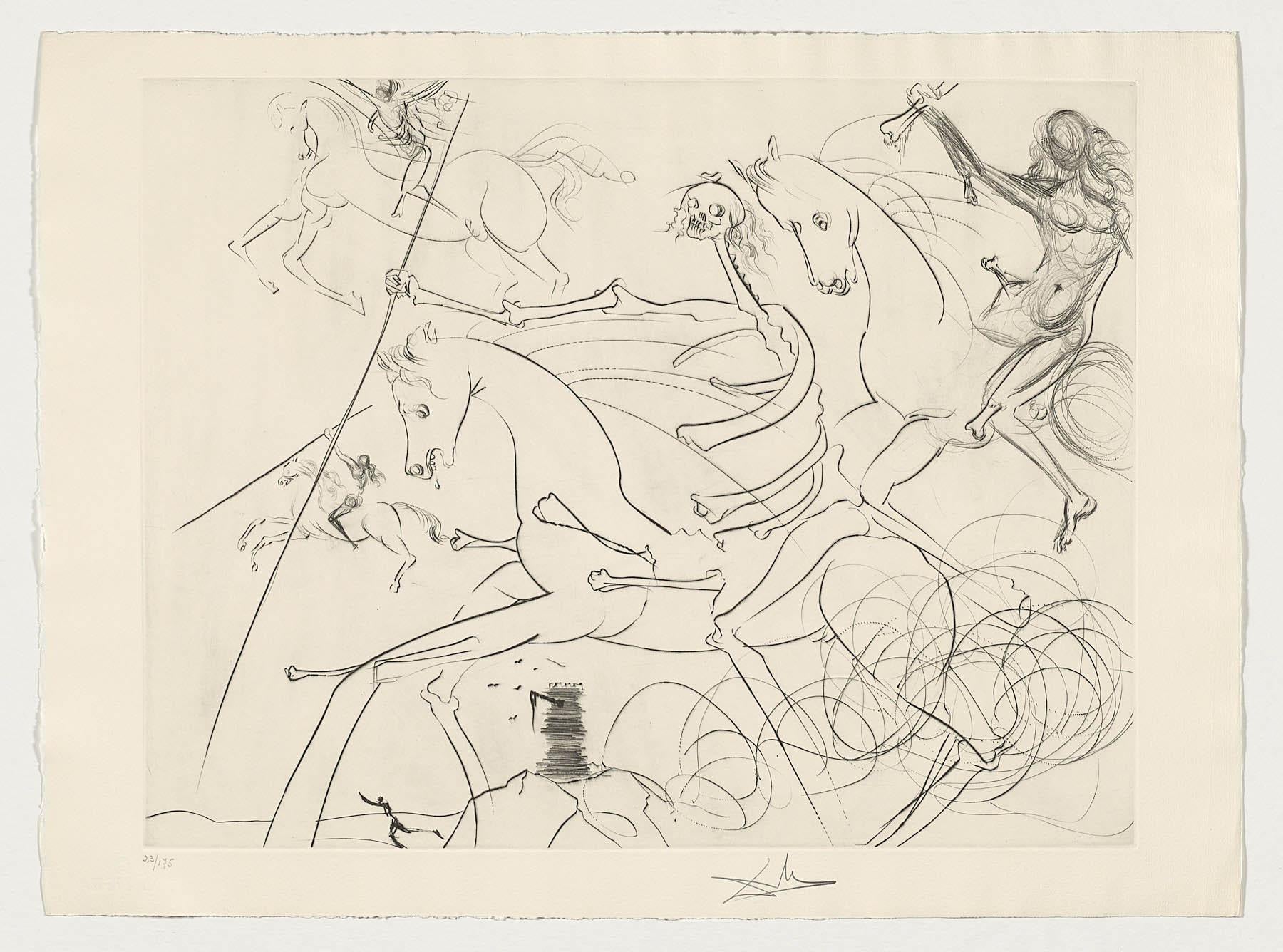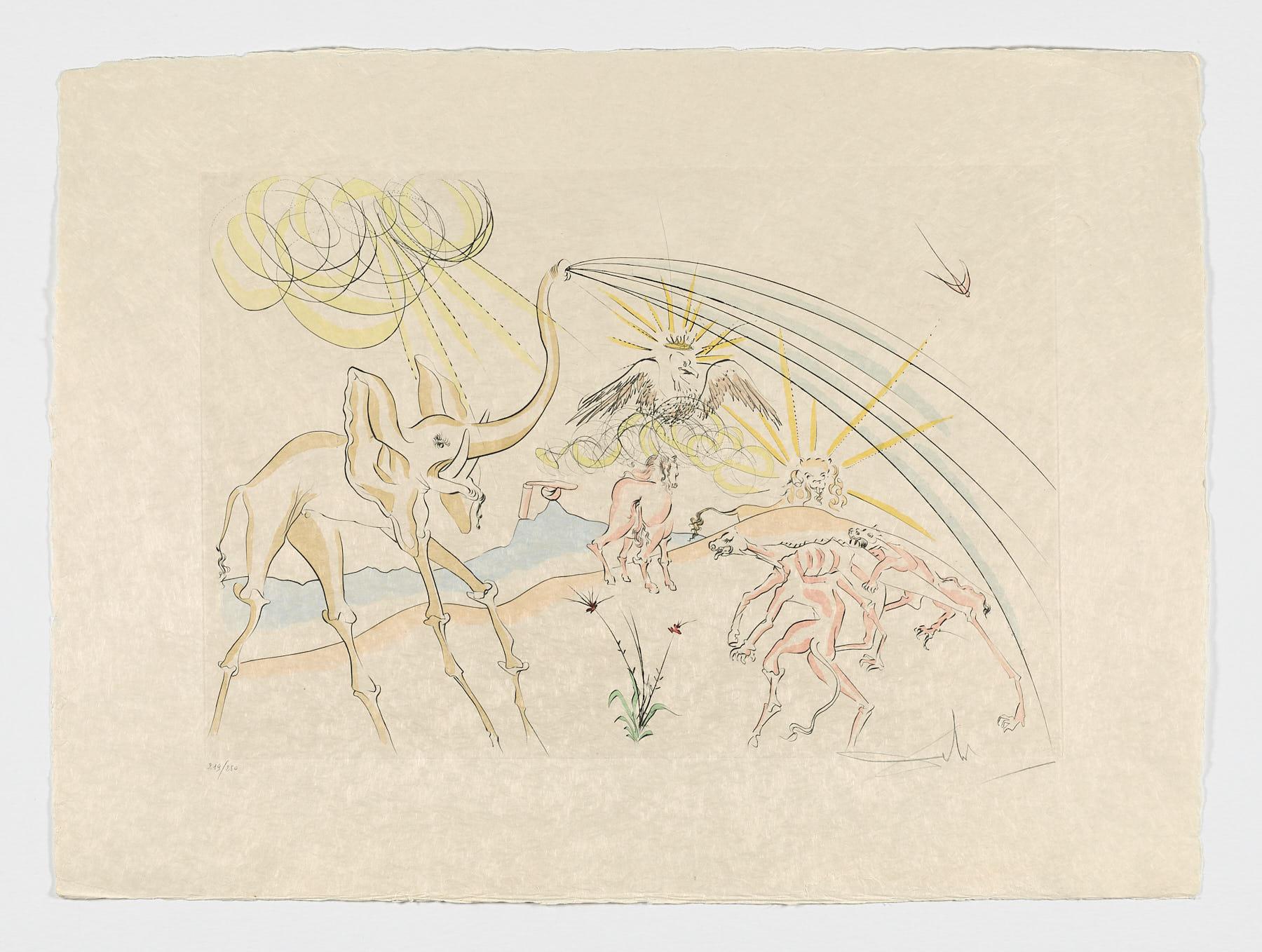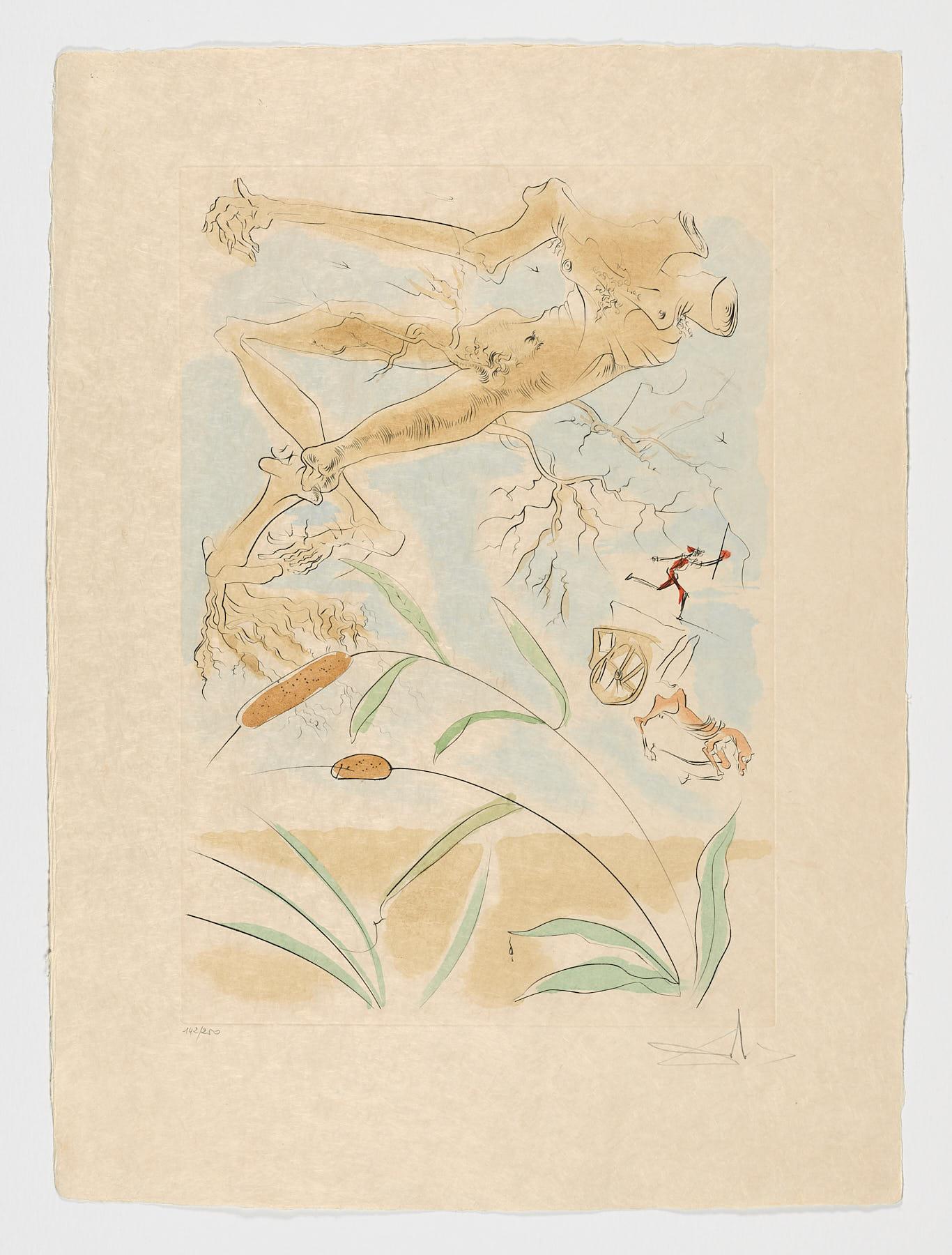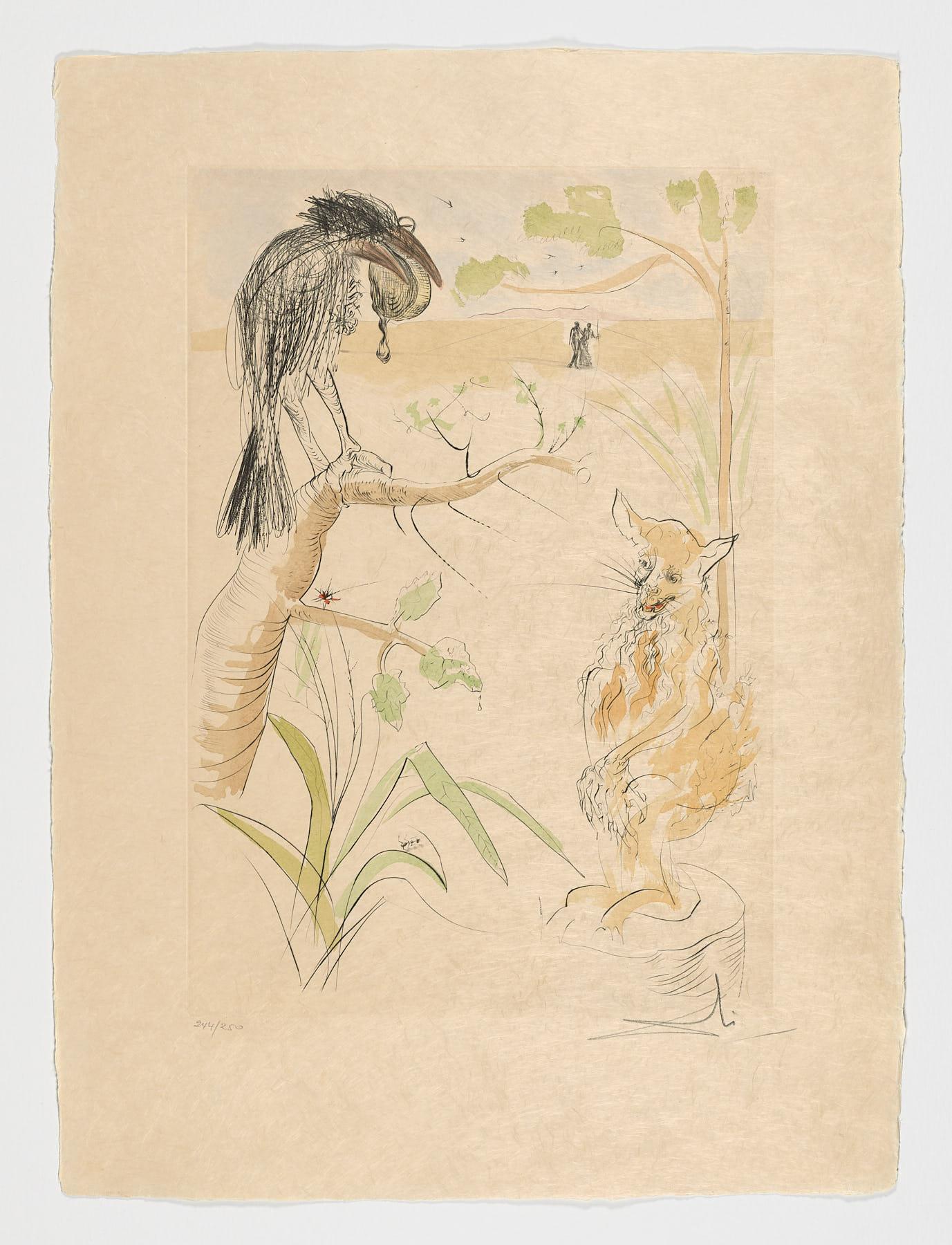Leonor FiniPas du chat (A)Unknown
Unknown
About the Item
- Creator:Leonor Fini (1908 - 1996, French)
- Creation Year:Unknown
- Dimensions:Height: 13 in (33.02 cm)Width: 18 in (45.72 cm)
- More Editions & Sizes:Edition of 30Price: $2,160
- Medium:
- Movement & Style:
- Period:
- Condition:
- Gallery Location:Columbia, MO
- Reference Number:1stDibs: LU1976214048352
Leonor Fini
Leonor Fini was the life of the party during the French Surrealist movement. A socialite with connections to some of the movement's biggest names, Fini was also an astoundingly gifted artist in her own right. In fact, many consider her to be the most fiercely independent female artist of the 20th century. A theatrical personality, Fini created prints, paintings and drawings that are widely revered for their sensuous qualities and raw energy.
Fini's life started off in a dramatic fashion, which was perhaps a portent of things to come. She was born in Buenos Aires, Argentina in 1907, but her parents separated soon after and her mother took her away to Trieste, Italy. Due to her father's attempts to kidnap her, Fini was often dressed as a boy throughout her childhood.
Fini was surrounded by artistic women in Trieste, and she naturally developed a love for art as well. By the time she was 17, she had become familiar with Renaissance art and Mannerist painting and was exhibiting her own portraits. In 1931, at just 24 years of age, Fini moved to Paris and became acquainted with influential artists Giorgio de Chirico and Carlos Carrà. She also met and started a romantic relationship with Surrealist pioneer Max Ernst, who introduced her to others in the movement.
Though she had no formal art education, Fini proved herself to be both technically masterful and creatively exceptional. Her work and her flamboyant personality attracted the attention of many of the 20th century's most celebrated artists and thinkers, including Salvador Dalí, Jean Cocteau, Albert Camus and Jean Genet, just to name a very few. She exhibited her work in many Parisian art galleries, including the gallery of Christian Dior before the fashion icon became a designer.
In the 1950s, Fini continued painting while immersing herself in other artistic and dramatic endeavors, including theater costume and mask design. She also designed posters for the Paris Opera and wardrobes for movies.
Fini continued living and painting in Paris for the rest of her life. She died in 1996.
On 1stDibs, find original Leonor Fini prints, paintings and drawings.
- ShippingRetrieving quote...Ships From: Columbia, MO
- Return PolicyThis item cannot be returned.
- Metamorphosis Cat (B)By Leonor FiniLocated in Columbia, MOLeonor Fini was born in Argentina in 1907 but travelled and lived in Europe with her mother from a young age. By 1931, she was in Paris, in the full swing of the Surrealist movement....Category
Mid-20th Century Surrealist Animal Prints
MaterialsEtching
- PoutBy Leonor FiniLocated in Columbia, MOLeonor Fini was born in Argentina in 1907 but travelled and lived in Europe with her mother from a young age. By 1931, she was in Paris, in the full swing of the Surrealist movement....Category
Mid-20th Century Surrealist Figurative Prints
MaterialsEtching
- HeaddressBy Leonor FiniLocated in Columbia, MOLeonor Fini was born in Argentina in 1907 but travelled and lived in Europe with her mother from a young age. By 1931, she was in Paris, in the full swing of the Surrealist movement....Category
Mid-20th Century Surrealist Figurative Prints
MaterialsEtching
- Metamorphosis Cat (A)By Leonor FiniLocated in Columbia, MOLeonor Fini was born in Argentina in 1907 but travelled and lived in Europe with her mother from a young age. By 1931, she was in Paris, in the full swing of the Surrealist movement....Category
Mid-20th Century Surrealist Animal Prints
MaterialsEtching
- Nymph CrownsBy Leonor FiniLocated in Columbia, MOLeonor Fini was born in Argentina in 1907 but travelled and lived in Europe with her mother from a young age. By 1931, she was in Paris, in the full swing of the Surrealist movement....Category
Mid-20th Century Surrealist Figurative Prints
MaterialsEtching
- The Nymphs (B)By Leonor FiniLocated in Columbia, MOLeonor Fini was born in Argentina in 1907 but travelled and lived in Europe with her mother from a young age. By 1931, she was in Paris, in the full swing of the Surrealist movement....Category
Mid-20th Century Surrealist Animal Prints
MaterialsEtching
- The Elephant and Jupiter's Monkey - Attr. to S.Dalì - 1974By Salvador DalíLocated in Roma, ITThe Elephant and Jupiter's Monkey. Mixed colored etching on Japan paper. Signed on the lower right margin. Numbered on the lower left margin. Edition of 249/250. The artwork is from...Category
1970s Surrealist Animal Prints
MaterialsEtching
- Spanish Artist hand signed limited edition original art print drypoint n16By Salvador DalíLocated in Miami, FLSalvador Dali (Spain, 1904-1989) 'Jinete apocalíptico', 1974 dry point, etching on paper 22.3 x 30.4 in. (56.5 x 77 cm.) Edition of 175 Unframed ID: DAL2001-016 Hand-signed by author ______________________________________________________ Salvador Felipe Jacinto Dalí i Domènech was a Spanish painter, sculptor, engraver, set designer and writer of the 20th century. An artist associated with surrealism, he is one of the most important figures in 20th century art, representing the archetype of the spectacular contemporary multifaceted artist. He develops his creative activity in various fields through the most diverse cultural formulas: painting, written media, performing arts, cinema, or public appearances in the press, radio, cinema, advertising, television, etc. Master of the most refined pictorial technique, especially drawing, along with various aesthetic languages - from impressionism, cubism, purism or late ultraism with Dadaist edges to the most radical surrealism, hyperrealism, pop-art or art optical—, will absorb every influence that is useful to build its own and personal language, halfway between technical tradition and thematic avant-garde. His paranoid-critical method is his main contribution to the surrealist movement and to the history of art as a new creative model with which Dalí's theories acquire theoretical entity - thanks to the successive interpretations that the Empordà artist made of his readings of Dalí's work. Sigmund Freud—and practice, applying it as a revealing liquid of images that can be represented plastically through multiple images, anamorphisms, relational mirages, irrational and heterogeneous symbolic images, pseudohallucinations, childhood memories, atavisms, obsessive ideas, etc., and recreating a polyphonic method capable of critically relating any visual or sensitive experience. With his method, Dalí makes paranoid delirium a whole mode of expression of an art that introduces us to the concrete irrationality that inhabits every creative process, constructing not only his works, but also his own character. as an artist. In Dalí, the relationship between his work and his personal history becomes evident. Much of the most significant biographical facts for the artist are implicitly or explicitly present in the content of his work and are the explanation of his complex and contradictory personality. In 1910, at the age of 6, he was enrolled by his father in the Hispano-French school of the Immaculate Conception of Figueres, where he learned French, his future language of culture. Dalí's first contact with Impressionism occurred in 1916, when he spent some time on the outskirts of Figueres, specifically at the Molí de la Torre estate, property of the Pichot family (intellectuals and artists), where he was the collection of the painter Ramón Pichot. In 1919 he participated for the first time in a group exhibition in the halls of the Societat de Concerts, and with a group of friends from the institute founded the magazine Studium, in which he published his first writings. A year later he moved to Madrid to study at the School of Fine Arts. In 1922 he won his first prize at the Concurs-exposició d'obres d'art originals d'students, held at the Galeries Dalmau (Barcelona). This same year he attended the School of Painting, Sculpture and Engraving in Madrid (Royal Academy of Fine Arts of San Fernando), and lived in the Student Residence, where he became friends with prominent personalities such as Luis Buñuel, Federico García Lorca, Pedro Garfias , Eugenio Montes, or Pepín Bello. However, a year later he was expelled from the Academy for his rebellious and revolutionary character, accused of leading a protest. It would be in 1927 when his surrealist period began, after having traveled to the Netherlands and France, meeting Flemish painters and Picasso. In Paris itself, in 1929, through Joan Miró, he came into contact with a group of surrealists headed...Category
1970s Surrealist Prints and Multiples
MaterialsPaper, Drypoint, Etching
- Spanish Artist hand signed limited edition original art print drypoint n14By Salvador DalíLocated in Miami, FLSalvador Dali (Spain, 1904-1989) 'Les Animaux Malades de la Peste', 1974 Serie: Le Bestiaire de La Fontaine dry point, aquatint on japanese paper 22.9 x 30.4 in. (58 x 77 cm.) Editio...Category
1970s Surrealist Prints and Multiples
MaterialsDrypoint, Paper, Aquatint
- Spanish Artist hand signed limited edition original art print drypoint n10By Salvador DalíLocated in Miami, FLSalvador Dali (Spain, 1904-1989) 'La Chêne et le Roseau', 1974 Serie: Le Bestiaire de La Fontaine dry point, aquatint on japanese paper 30.9 x 22.7 in. (78.4 x 57.5 cm.) Edition of 2...Category
1970s Surrealist Prints and Multiples
MaterialsDrypoint, Aquatint, Paper
- Spanish Artist hand signed limited edition original art print drypoint n8By Salvador DalíLocated in Miami, FLSalvador Dali (Spain, 1904-1989) 'La Cour du Lion', 1974 Serie: Le Bestiaire de La Fontaine dry point, aquatint on japanese paper 30.8 x 22.9 in. (78 x 58 cm.) Edition of 250 Unframed ID: DAL2001-008 Hand-signed by author It appears reviewed in the catalog raisonné: The official catalog of the graphic works of Salvador Dalí. Albert Field. Page: 2/93. Nr. 74-1 C. ______________________________________________________ Salvador Felipe Jacinto Dalí i Domènech was a Spanish painter, sculptor, engraver, set designer and writer of the 20th century. An artist associated with surrealism, he is one of the most important figures in 20th century art, representing the archetype of the spectacular contemporary multifaceted artist. He develops his creative activity in various fields through the most diverse cultural formulas: painting, written media, performing arts, cinema, or public appearances in the press, radio, cinema, advertising, television, etc. Master of the most refined pictorial technique, especially drawing, along with various aesthetic languages - from impressionism, cubism, purism or late ultraism with Dadaist edges to the most radical surrealism, hyperrealism, pop-art or art optical—, will absorb every influence that is useful to build its own and personal language, halfway between technical tradition and thematic avant-garde. His paranoid-critical method is his main contribution to the surrealist movement and to the history of art as a new creative model with which Dalí's theories acquire theoretical entity - thanks to the successive interpretations that the Empordà artist made of his readings of Dalí's work. Sigmund Freud—and practice, applying it as a revealing liquid of images that can be represented plastically through multiple images, anamorphisms, relational mirages, irrational and heterogeneous symbolic images, pseudohallucinations, childhood memories, atavisms, obsessive ideas, etc., and recreating a polyphonic method capable of critically relating any visual or sensitive experience. With his method, Dalí makes paranoid delirium a whole mode of expression of an art that introduces us to the concrete irrationality that inhabits every creative process, constructing not only his works, but also his own character. as an artist. In Dalí, the relationship between his work and his personal history becomes evident. Much of the most significant biographical facts for the artist are implicitly or explicitly present in the content of his work and are the explanation of his complex and contradictory personality. In 1910, at the age of 6, he was enrolled by his father in the Hispano-French school of the Immaculate Conception of Figueres, where he learned French, his future language of culture. Dalí's first contact with Impressionism occurred in 1916, when he spent some time on the outskirts of Figueres, specifically at the Molí de la Torre estate, property of the Pichot family (intellectuals and artists), where he was the collection of the painter Ramón Pichot. In 1919 he participated for the first time in a group exhibition in the halls of the Societat de Concerts, and with a group of friends from the institute founded the magazine Studium, in which he published his first writings. A year later he moved to Madrid to study at the School of Fine Arts. In 1922 he won his first prize at the Concurs-exposició d'obres d'art originals d'students, held at the Galeries Dalmau (Barcelona). This same year he attended the School of Painting, Sculpture and Engraving in Madrid (Royal Academy of Fine Arts of San Fernando), and lived in the Student Residence, where he became friends with prominent personalities such as Luis Buñuel, Federico García Lorca, Pedro Garfias , Eugenio Montes, or Pepín Bello. However, a year later he was expelled from the Academy for his rebellious and revolutionary character, accused of leading a protest. It would be in 1927 when his surrealist period began, after having traveled to the Netherlands and France, meeting Flemish painters and Picasso. In Paris itself, in 1929, through Joan Miró, he came into contact with a group of surrealists headed...Category
1970s Surrealist Prints and Multiples
MaterialsDrypoint, Paper, Aquatint
- Chevalier Royal de L’ApocalypseBy Salvador DalíLocated in Hollywood, FLARTIST: Salvador Dali TITLE: Chevalier Royal de L'Apocalypse MEDIUM: Etching SIGNED: Hand Signed EDITION NUMBER: 32/100 MEASUREMENTS: 20" x 25.75" YEAR: 1972 FRAMED: No COND...Category
1970s Surrealist Animal Prints
MaterialsEtching
